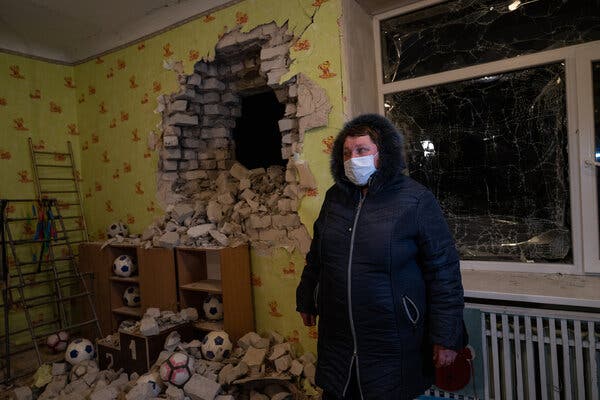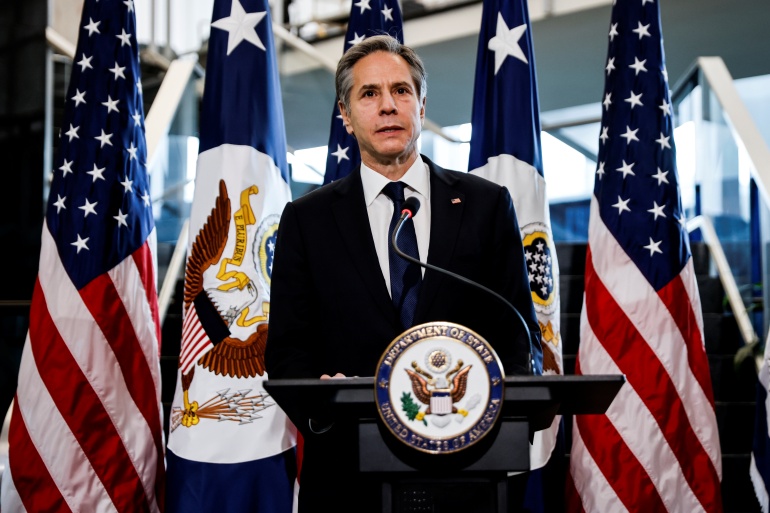U.S. says Russia moving toward “imminent invasion” of Ukraine amid “false-flag” concerns over shelling claims in Donbas

A kindergarten building that Ukraine's military said was hit by a shell fired by Russian-backed separatists in Stanytsia Luhanska, in the Luhansk area of eastern Ukraine's Donbas region, February 17, 2022.
Kyiv, TGO: Ukraine’s military and the Russian-backed separatists it has battled for eight years in the country’s eastern Donbas region both accused the other side of opening fire on Thursday in violation of ceasefire agreements that have been shaky, at best, since they were signed seven years ago.
As the reported shelling raised tensions and despite Russia’s claims to be pulling forces back from Ukraine’s borders the Biden administration said “evidence on the ground” showed Russia was “moving toward an imminent invasion” of its neighbor.
“We have reason to believe that they are engaged in a false-flag operation to have an excuse to go in,” President Biden told reporters on Thursday. “Every indication we have is they are prepared to go into Ukraine, attack Ukraine.”
The United States and its NATO partners have dismissed Moscow’s assertions of an initial force drawdown along Ukraine’s northern, eastern and southern borders, saying that President Vladimir Putin’s military appears instead to be bolstering troop numbers.
America and its allies have also warned for weeks that Russia could try to stage a “false-flag” incident including a faked attack by Ukrainian forces on the rebels in Donbas to use as a pretext to invade Ukraine. On Thursday, amid the claims of shelling from both sides, NATO Secretary Jens Stoltenberg said the alliance was “concerned” that Russia was trying to do just that.

With U.S. Secretary of State Antony Blinken making an unscheduled stop in New York to address a Security Council meeting requested by Ukraine, a senior State Department official echoed Stoltenberg’s concerns about possible Russian preparations to fabricate a pretext for an invasion.
The official said it wasn’t immediately clear whether the shelling was actually the false-flag incident the U.S. has worried about, but called it “perhaps the most perilous moment for peace and security since the end of the Cold War.”
“We’ve said for some time the Russians might do something like this in order to justify a military conflict,” U.S. Secretary of Defense Lloyd Austin, in Brussels for a NATO meeting, said on Thursday, adding that the allies would “be watching this very closely.”
U.S. Ambassador to the United Nations Linda Thomas Greenfield told reporters that she had personally asked Blinken to address the Security Council on Thursday “to convey the gravity of the situation” .
“The evidence on the ground is that Russia is moving toward an imminent invasion. This is a crucial moment,” Thomas-Greenfield said. “This morning’s Council meeting should not distract us from that fact it should focus on what is happening right now in Ukraine.”
The Russian-backed separatists who control two breakaway districts within the Donbas region, Luhansk and Donetsk, claimed on Thursday that Ukrainian forces had opened fire on a number of villages inside their territory, but that they were still checking for casualties. Officials from the self-proclaimed Luhansk and Donetsk “People’s Republics” said Ukrainian security forces “continue to flagrantly violate the ceasefire regime using heavy weapons.”
Ukraine’s military said it was the separatists who had violated the ceasefire by shelling government-held villages, including a mortar that hit a kindergarten but caused no casualties.
It has long been the policy of the Ukraine’s armed forces in Donbas not to respond to provocations from the rebels unless their lives are in immediate danger. On Thursday, Ukraine’s military said in a statement that its forces “took measures” to respond to the incoming rebel fire, but provided no details.
There have been regular skirmishes between the two sides in Donbas since 2014, when Russia last sent in troops to support the rebels, and they have routinely accused each other of violating a ceasefire.
Russia’s 2014 invasion led to Putin’s unilateral annexation of Ukraine’s Crimean Peninsula. Ceasefire agreements signed in 2014 and 2015, known as the Minsk Accords, halted large-scale combat but the war has simmered for almost eight years, leaving 14,000 people dead, according to Ukraine’s government.
Russia’s recent buildup of around 150,000 troops just over the border from the Donbas region in the east, in Belarus to the north and Crimea to the south, which began in the autumn, has sent tensions soaring. Russia claims the surge of forces has always been for military exercises and that it poses no threat to Ukraine or any other nation, but has refused to offer any real explanation for the biggest buildup of military might in Europe since the Cold War.
Defense officials in Moscow have said since Tuesday that troops and military hardware are pulling back, having completed some of the drills. Western intelligence officials say, on the contrary, that Russia has moved roughly 7,000 more troops close to the borders in recent days.
On Thursday an American official told reporters that not only were Russian troops moving out of assembly areas, closer to the Ukrainian border and into attack positions, but the Russian units remaining behind had begun fortifying their positions.
President Joe Biden said this week that Putin’s forces remain in position to launch an invasion at any time, at short notice, if the Russian leader decides to order one. Mr. Biden, his European counterparts and the G7 have all warned Putin for months that any new invasion of Ukraine would be met with “swift and severe” sanctions.
Ukraine has aspirations to join NATO but is not a member of the Western military alliance now, and the U.S. and other NATO states have ruled out sending troops in to back up Ukraine’s forces directly. The transatlantic partners have made it very clear, however, that if any Russian aggression were to threaten a NATO member — and there are many in the region they would “stand united to defend each other.”
The U.S. and its allies continue to send more troops and weaponry into Eastern and Northern European NATO states to bolster the alliance’s defenses.
But American officials told reporters on Wednesday that the window for a potential Russian attack against Ukraine had been extended by four to five days, suggesting hopes for a diplomatic solution to the crisis had not completely evaporated.
More than a week of intense talks have yielded no signs of significant progress, however, and as Kremlin spokesman Dmitry Peskov said bluntly on Thursday, “the situation near the borders of Russia can ignite at any moment.”
After waiting for weeks for Moscow to respond fully to a number of proposals sent from Washington to the Kremlin in a bid to find anything the two sides can agree on to ease the tension, the Biden administration confirmed on Thursday that it had a formal reply. A State Department official said it was handed to U.S. Ambassador John Sullivan in Moscow.
Russian Foreign Minister Sergey Lavrov said earlier that his country would publish its response within hours of delivering it to Washington.


